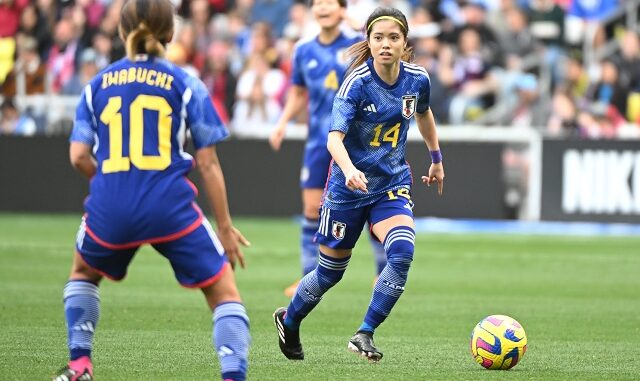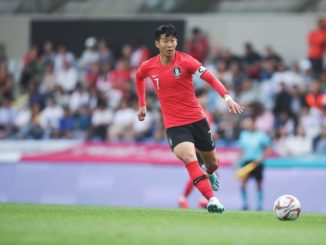
As with any World Cup squad announcement, our eyes naturally scan for surprise inclusions and notable omissions.
Arguably these two catalysts play an important role in generating interest during the build up to a tournament, and Nadeshiko Japan have not disappointed in this regard. But how much of an impact will the final selection have on their performance on the big stage?
Futoshi Ikeda has named his 23 player squad that will head to Australia & New Zealand next month for the ninth edition of FIFA Women’s World Cup. Surprisingly this far out, this is a final cut selection that will only be altered should an injury arise before the side departs for its New Zealand base camp mid-July.
Big league stars such as Manchester City’s Yui Hasegawa, Liverpool’s Fuka Nagano and Portland Thorns’ Hina Sugita are all present and correct, no surprises there. Angel City’s dynamic attacker Jun Endo also makes the cut, despite suffering a late injury scare.
The former Urawa Reds defender’s unwavering faith in youth remains intact as three members of his 2022 U20 World Cup squad are set to make an appearance on the big stage. Sturdy centre-back Rion Ishikawa, ferocious forward Aoba Fujino and Hammarby by-way-of Chelsea attacker Maika Hamano have all been deemed capable and ready for their first taste of a major tournament at senior level.
But without doubt attention will turn to one very notable omission. Some might say one of gargantuan proportions.
Mana Iwabuchi has struggled to find form and ample playing time at club level since leaving Aston Villa for Arsenal in 2021. Despite a fairly promising start under Jonas Eidevall, the 2011 World Cup winner has experienced a lacklustre run of form, partially caused by injury and fitness issues.
Making just five appearances for Arsenal in the first half of the 2022/23 WSL season, she would then go on to close the year on loan at North London rivals Tottenham in a move that has done little to aid a return to prominence.
On the international stage she has suffered similar fortune and has not produced a notable performance under Ikeda to date.
COVID-19 ruled her out for much of the 2022 Women’s Asian Cup in India and necessary ankle surgery was the reason for her absence from the EAFF E-1 Championship in August last year. Being benched by Arsenal was the reason for her omission in a run of friendlies at the end of last year and, like many others, she struggled to standout at the She Believes Cup earlier this year.
Her ongoing condition concerns are highlighted by the considerable amount of tape wrapped around her leg while playing for Spurs. All of this has likely led to Ikeda’s decision to leave her out of his selection in favour of a more dependable, and perhaps deserving, alternative.
Given her leadership qualities and major tournament experience the call is seemingly harsh, but not without logic given the above factors.
The Nadeshiko boss is not without empathy for the long-term servant of the national team and has explained the reasons behind his decison:
“Iwabuchi has helped shape this Nadeshiko side with her efforts both on the pitch and off the pitch and has truly fought for this team,” he explained
“By considering the individual condition and situation of each member, both at club level and international level, I have arrived at this final selection”.
“Together with many other players under consideration, I have decided not to include Iwabuchi for this tournament”.
Nadeshiko supporters have much to be optimistic about, however, as the alternative approach is both tantalising and formidable.
A conundrum of the Ikeda system is the means by which the technically gifted duo of Hina Sugita and Jun Endo can fit into the same starting 11.
For Japan they play the same left wingback role and one is considered a replacement for the other. At club level Endo plays higher up the pitch and in Iwabuchi’s absence she could join the front three together with WE League golden boot winner Rico Ueki and rising star Aoba Fujino. Sugita would remain at left wingback, providing width to a highly capable attack.
Further back it seems Ikeda’s trademark back three will continue to be the order of the day. Shiori Miyake and Miyabi Moriya of INAC Kobe return to the side after proving to be crucial components for their club’s own version of the system. It is likely that positional sense and tactical familiarity are key factors for selection in this part of the pitch.
Aside from the headline grabbing decision on Iwabuchi there are no notable surprises here. Preparations appear to be coming to a head and it is unlikely there will be much deviance from the preferred selection of personal and tactical approach as we head into the first World Cup of the Ikeda era.
This cast of characters will be tested in one final run-out on 14 July against Panama in Sendai, Japan.
Photo: Japan Football Association
Listen to the latest episode of The Asian Game Podcast




